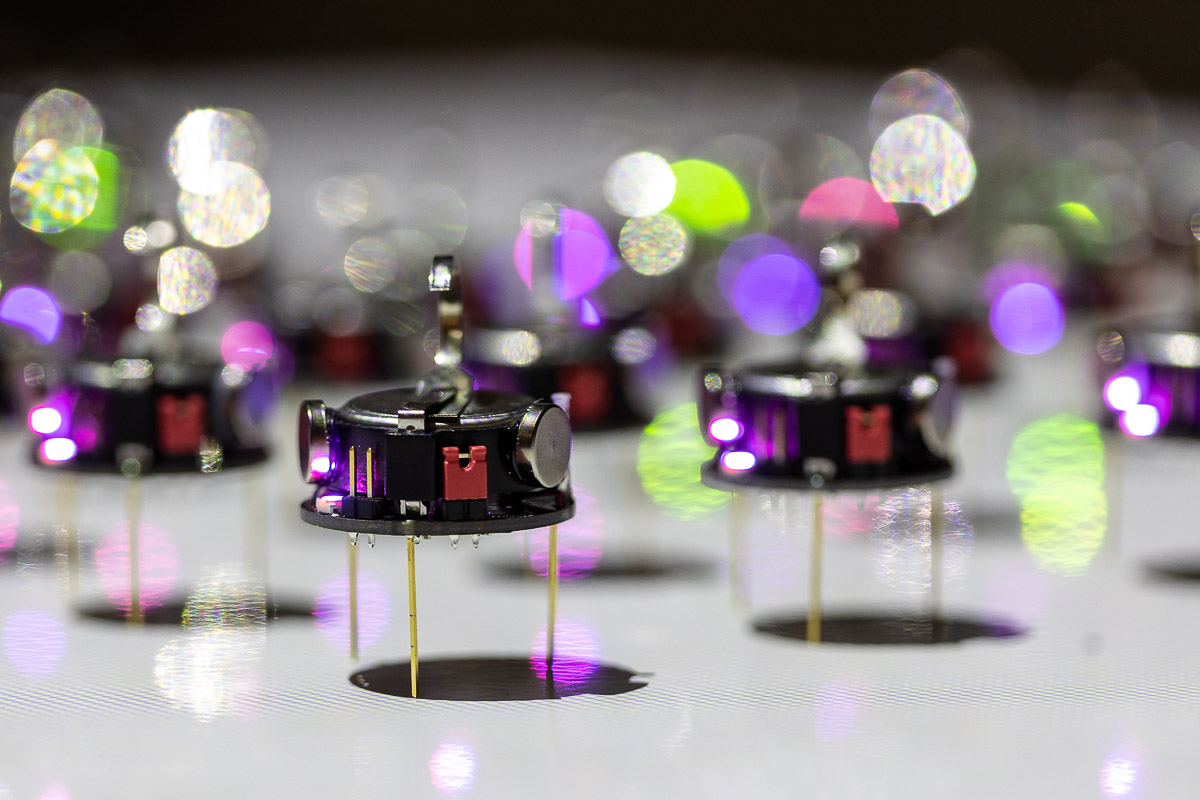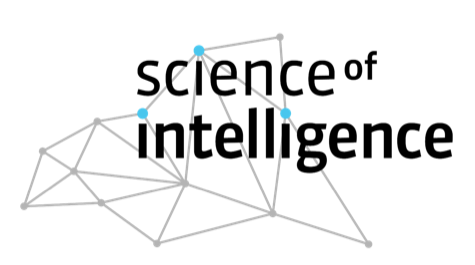An Adaptive Exploration-Exploitation Scenario

©SCIoI
In recent decades, many studies have investigated collective decision making in different scenarios, both from a biological (analytic) and a swarm robotic (synthetic) background. However, many modeling studies on collective decision making in non-spatial settings assume fixed interaction networks and fixed social interaction rules. In contrast, in most studies on collective decision making in animal groups and corresponding bioinspired swarm robotics systems, the interaction networks emerge from individual motion, spatial features, and social interaction rules. As a result, in corresponding consensus decision making processes about the group’s direction of motion, the actual decision making process and the network properties can not be disentangled.
However, in collective decision making in biological multi-agent systems, the actual decision process is not necessarily as tightly coupled to collective movement, as assumed in many flocking models, but also clearly not completely independent, as considered in idealized static network models. Here, in a first approximation, we assume that individual agents in a collective can tune their (social) decision behavior and their (interaction) network position through adaptive movements, independently. For example, individual fish in schools under higher predation risk can, on the one hand, increase their general responsiveness (e.g., decrease escape thresholds, change social response rule), or, on the other hand, could adapt their positioning with respect to others, that in turn will affect the school structure.
Recent work combining experiments and modeling co-authored by P. Romanczuk (Sosna et al. 2019) suggests that in fish schools with increased risk perception, the change in size of collective escape cascades is primarily driven by adaptation of the network structure, while the individual responsiveness appears not to change significantly. However, this is likely not the case for all biological systems. For example, the adaptation of the (social) decision rules may turn out to be the “method of choice” for some forms of collective computations, if decision making and movement live on vastly different time-scales.
Similarly to natural swarms, also in the synthetic system of swarm robots (Hamann 2018), the network topology is tightly constrained by physical properties (e.g., location and communication range) and changes on the time scale of seconds. In contrast, interaction rules can be freely programmed and can be processed on the time scale of milliseconds. We predict that the complementary (co-)adaptation of network topology and interaction rules by individual agents will have non-trivial effects on the speed and accuracy of the resulting collective decision-making processes. In previous works, we have found indicators, such as dependency on neighborhood size (Valentini and Hamann 2015, Valentini et al. 2015). The main objective of this project is to systematically investigate how collective decision-making systems are able to navigate the speed-accuracy tradeoff through local modulation of the (a) social interaction rules of individual agents, and (b) through adaptations of the spatial interaction networks.
Related Publications +
2756394
proj027
1
apa
50
creator
desc
year
20195
https://www.scienceofintelligence.de/wp-content/plugins/zotpress/
%7B%22status%22%3A%22success%22%2C%22updateneeded%22%3Afalse%2C%22instance%22%3Afalse%2C%22meta%22%3A%7B%22request_last%22%3A0%2C%22request_next%22%3A0%2C%22used_cache%22%3Atrue%7D%2C%22data%22%3A%5B%7B%22key%22%3A%22KFUW6AEK%22%2C%22library%22%3A%7B%22id%22%3A2756394%7D%2C%22meta%22%3A%7B%22creatorSummary%22%3A%22Winklmayr%20et%20al.%22%2C%22parsedDate%22%3A%222023%22%2C%22numChildren%22%3A1%7D%2C%22bib%22%3A%22%3Cdiv%20class%3D%5C%22csl-bib-body%5C%22%20style%3D%5C%22line-height%3A%202%3B%20padding-left%3A%201em%3B%20text-indent%3A-1em%3B%5C%22%3E%5Cn%20%20%3Cdiv%20class%3D%5C%22csl-entry%5C%22%3EWinklmayr%2C%20C.%2C%20Kao%2C%20A.%20B.%2C%20Bak-Coleman%2C%20J.%20B.%2C%20%26amp%3B%20Romanczuk%2C%20P.%20%282023%29.%20Collective%20decision%20strategies%20in%20the%20presence%20of%20spatio-temporal%20correlations.%20%3Ci%3ECollective%20Intelligence%3C%5C%2Fi%3E.%20%3Ca%20class%3D%27zp-ItemURL%27%20href%3D%27https%3A%5C%2F%5C%2Fdoi.org%5C%2F10.1177%5C%2F26339137221148675%27%3Ehttps%3A%5C%2F%5C%2Fdoi.org%5C%2F10.1177%5C%2F26339137221148675%3C%5C%2Fa%3E%3C%5C%2Fdiv%3E%5Cn%3C%5C%2Fdiv%3E%22%2C%22data%22%3A%7B%22itemType%22%3A%22journalArticle%22%2C%22title%22%3A%22Collective%20decision%20strategies%20in%20the%20presence%20of%20spatio-temporal%20correlations%22%2C%22creators%22%3A%5B%7B%22creatorType%22%3A%22author%22%2C%22firstName%22%3A%22Claudia%22%2C%22lastName%22%3A%22Winklmayr%22%7D%2C%7B%22creatorType%22%3A%22author%22%2C%22firstName%22%3A%22Albert%20B.%22%2C%22lastName%22%3A%22Kao%22%7D%2C%7B%22creatorType%22%3A%22author%22%2C%22firstName%22%3A%22Joseph%20B.%22%2C%22lastName%22%3A%22Bak-Coleman%22%7D%2C%7B%22creatorType%22%3A%22author%22%2C%22firstName%22%3A%22Pawel%22%2C%22lastName%22%3A%22Romanczuk%22%7D%5D%2C%22abstractNote%22%3A%22%22%2C%22date%22%3A%222023%22%2C%22language%22%3A%22%22%2C%22DOI%22%3A%2210.1177%5C%2F26339137221148675%22%2C%22ISSN%22%3A%22%22%2C%22url%22%3A%22https%3A%5C%2F%5C%2Fdoi.org%5C%2F10.1177%5C%2F26339137221148675%22%2C%22collections%22%3A%5B%5D%2C%22dateModified%22%3A%222025-05-30T15%3A00%3A29Z%22%7D%7D%2C%7B%22key%22%3A%22DCIZ9S8P%22%2C%22library%22%3A%7B%22id%22%3A2756394%7D%2C%22meta%22%3A%7B%22creatorSummary%22%3A%22Raoufi%20et%20al.%22%2C%22parsedDate%22%3A%222023%22%2C%22numChildren%22%3A1%7D%2C%22bib%22%3A%22%3Cdiv%20class%3D%5C%22csl-bib-body%5C%22%20style%3D%5C%22line-height%3A%202%3B%20padding-left%3A%201em%3B%20text-indent%3A-1em%3B%5C%22%3E%5Cn%20%20%3Cdiv%20class%3D%5C%22csl-entry%5C%22%3ERaoufi%2C%20M.%2C%20Romanczuk%2C%20P.%2C%20%26amp%3B%20Hamann%2C%20H.%20%282023%29.%20Estimation%20of%20continuous%20environments%20by%20robot%20swarms%3A%20Correlated%20networks%20and%20decision-making.%20%3Ci%3EICRA%202023%3C%5C%2Fi%3E.%20%3Ca%20class%3D%27zp-DOIURL%27%20href%3D%27https%3A%5C%2F%5C%2Fdoi.org%5C%2F10.1109%5C%2Ficra48891.2023.10161354%27%3Ehttps%3A%5C%2F%5C%2Fdoi.org%5C%2F10.1109%5C%2Ficra48891.2023.10161354%3C%5C%2Fa%3E%3C%5C%2Fdiv%3E%5Cn%3C%5C%2Fdiv%3E%22%2C%22data%22%3A%7B%22itemType%22%3A%22conferencePaper%22%2C%22title%22%3A%22Estimation%20of%20continuous%20environments%20by%20robot%20swarms%3A%20Correlated%20networks%20and%20decision-making%22%2C%22creators%22%3A%5B%7B%22creatorType%22%3A%22author%22%2C%22firstName%22%3A%22Mohsen%22%2C%22lastName%22%3A%22Raoufi%22%7D%2C%7B%22creatorType%22%3A%22author%22%2C%22firstName%22%3A%22Pawel%22%2C%22lastName%22%3A%22Romanczuk%22%7D%2C%7B%22creatorType%22%3A%22author%22%2C%22firstName%22%3A%22Heiko%22%2C%22lastName%22%3A%22Hamann%22%7D%5D%2C%22abstractNote%22%3A%22%22%2C%22date%22%3A%222023%22%2C%22proceedingsTitle%22%3A%22ICRA%202023%22%2C%22conferenceName%22%3A%22%22%2C%22language%22%3A%22%22%2C%22DOI%22%3A%2210.1109%5C%2Ficra48891.2023.10161354%22%2C%22ISBN%22%3A%22%22%2C%22url%22%3A%22%22%2C%22collections%22%3A%5B%5D%2C%22dateModified%22%3A%222025-05-30T15%3A00%3A29Z%22%7D%7D%2C%7B%22key%22%3A%229X24UTF7%22%2C%22library%22%3A%7B%22id%22%3A2756394%7D%2C%22meta%22%3A%7B%22creatorSummary%22%3A%22Raoufi%20et%20al.%22%2C%22parsedDate%22%3A%222023%22%2C%22numChildren%22%3A1%7D%2C%22bib%22%3A%22%3Cdiv%20class%3D%5C%22csl-bib-body%5C%22%20style%3D%5C%22line-height%3A%202%3B%20padding-left%3A%201em%3B%20text-indent%3A-1em%3B%5C%22%3E%5Cn%20%20%3Cdiv%20class%3D%5C%22csl-entry%5C%22%3ERaoufi%2C%20M.%2C%20Romanczuk%2C%20P.%2C%20%26amp%3B%20Hamann%2C%20H.%20%282023%29.%20%3Ci%3EInter-individual%20Variations%20in%20Swarm%20Robotics%20with%20the%20Case%20Study%20of%20Kilobots%3C%5C%2Fi%3E.%20ICRA%202023%5C%2Fworkshop%20%26%23x201C%3BHeterogeneity%20in%20Multi-Robot%20Systems.%26%23x201D%3B%20%3Ca%20class%3D%27zp-ItemURL%27%20href%3D%27https%3A%5C%2F%5C%2Fraaslab.org%5C%2Ficra2023-hmrs%5C%2F%23contr%27%3Ehttps%3A%5C%2F%5C%2Fraaslab.org%5C%2Ficra2023-hmrs%5C%2F%23contr%3C%5C%2Fa%3E%3C%5C%2Fdiv%3E%5Cn%3C%5C%2Fdiv%3E%22%2C%22data%22%3A%7B%22itemType%22%3A%22document%22%2C%22title%22%3A%22Inter-individual%20Variations%20in%20Swarm%20Robotics%20with%20the%20Case%20Study%20of%20Kilobots%22%2C%22creators%22%3A%5B%7B%22creatorType%22%3A%22author%22%2C%22firstName%22%3A%22Mohsen%22%2C%22lastName%22%3A%22Raoufi%22%7D%2C%7B%22creatorType%22%3A%22author%22%2C%22firstName%22%3A%22Pawel%22%2C%22lastName%22%3A%22Romanczuk%22%7D%2C%7B%22creatorType%22%3A%22author%22%2C%22firstName%22%3A%22Heiko%22%2C%22lastName%22%3A%22Hamann%22%7D%5D%2C%22abstractNote%22%3A%22%22%2C%22date%22%3A%222023%22%2C%22language%22%3A%22%22%2C%22url%22%3A%22https%3A%5C%2F%5C%2Fraaslab.org%5C%2Ficra2023-hmrs%5C%2F%23contr%22%2C%22collections%22%3A%5B%5D%2C%22dateModified%22%3A%222025-05-30T15%3A00%3A29Z%22%7D%7D%2C%7B%22key%22%3A%22HCGYVZHP%22%2C%22library%22%3A%7B%22id%22%3A2756394%7D%2C%22meta%22%3A%7B%22creatorSummary%22%3A%22Raoufi%20et%20al.%22%2C%22parsedDate%22%3A%222023%22%2C%22numChildren%22%3A1%7D%2C%22bib%22%3A%22%3Cdiv%20class%3D%5C%22csl-bib-body%5C%22%20style%3D%5C%22line-height%3A%202%3B%20padding-left%3A%201em%3B%20text-indent%3A-1em%3B%5C%22%3E%5Cn%20%20%3Cdiv%20class%3D%5C%22csl-entry%5C%22%3ERaoufi%2C%20M.%2C%20Romanczuk%2C%20P.%2C%20%26amp%3B%20Hamann%2C%20H.%20%282023%29.%20Individuality%20in%20Swarm%20Robots%20with%20the%20Case%20Study%20of%20Kilobots%3A%20Noise%2C%20Bug%2C%20or%20Feature%3F%20%3Ci%3EArtificial%20Life%20%28ALife%29%202023%3C%5C%2Fi%3E.%20%3Ca%20class%3D%27zp-DOIURL%27%20href%3D%27https%3A%5C%2F%5C%2Fdoi.org%5C%2F10.1162%5C%2Fisal_a_00623%27%3Ehttps%3A%5C%2F%5C%2Fdoi.org%5C%2F10.1162%5C%2Fisal_a_00623%3C%5C%2Fa%3E%3C%5C%2Fdiv%3E%5Cn%3C%5C%2Fdiv%3E%22%2C%22data%22%3A%7B%22itemType%22%3A%22conferencePaper%22%2C%22title%22%3A%22Individuality%20in%20Swarm%20Robots%20with%20the%20Case%20Study%20of%20Kilobots%3A%20Noise%2C%20Bug%2C%20or%20Feature%3F%22%2C%22creators%22%3A%5B%7B%22creatorType%22%3A%22author%22%2C%22firstName%22%3A%22Mohsen%22%2C%22lastName%22%3A%22Raoufi%22%7D%2C%7B%22creatorType%22%3A%22author%22%2C%22firstName%22%3A%22Pawel%22%2C%22lastName%22%3A%22Romanczuk%22%7D%2C%7B%22creatorType%22%3A%22author%22%2C%22firstName%22%3A%22Heiko%22%2C%22lastName%22%3A%22Hamann%22%7D%5D%2C%22abstractNote%22%3A%22%22%2C%22date%22%3A%222023%22%2C%22proceedingsTitle%22%3A%22Artificial%20Life%20%28ALife%29%202023%22%2C%22conferenceName%22%3A%22%22%2C%22language%22%3A%22%22%2C%22DOI%22%3A%2210.1162%5C%2Fisal_a_00623%22%2C%22ISBN%22%3A%22%22%2C%22url%22%3A%22https%3A%5C%2F%5C%2Farxiv.org%5C%2Fabs%5C%2F2305.16063%22%2C%22collections%22%3A%5B%5D%2C%22dateModified%22%3A%222025-05-30T15%3A00%3A29Z%22%7D%7D%2C%7B%22key%22%3A%222N3QGN98%22%2C%22library%22%3A%7B%22id%22%3A2756394%7D%2C%22meta%22%3A%7B%22creatorSummary%22%3A%22Mengers%20et%20al.%22%2C%22parsedDate%22%3A%222024%22%2C%22numChildren%22%3A1%7D%2C%22bib%22%3A%22%3Cdiv%20class%3D%5C%22csl-bib-body%5C%22%20style%3D%5C%22line-height%3A%202%3B%20padding-left%3A%201em%3B%20text-indent%3A-1em%3B%5C%22%3E%5Cn%20%20%3Cdiv%20class%3D%5C%22csl-entry%5C%22%3EMengers%2C%20V.%2C%20Raoufi%2C%20M.%2C%20Brock%2C%20O.%2C%20Hamann%2C%20H.%2C%20%26amp%3B%20Romanczuk%2C%20P.%20%282024%29.%20Leveraging%20Uncertainty%20in%20Collective%20Opinion%20Dynamics%20with%20Heterogeneity.%20%3Ci%3EScientific%20Reports%3C%5C%2Fi%3E%2C%20%3Ci%3E14%3C%5C%2Fi%3E%281%29%2C%2027314.%20%3Ca%20class%3D%27zp-DOIURL%27%20href%3D%27https%3A%5C%2F%5C%2Fdoi.org%5C%2F10.1038%5C%2Fs41598-024-78856-8%27%3Ehttps%3A%5C%2F%5C%2Fdoi.org%5C%2F10.1038%5C%2Fs41598-024-78856-8%3C%5C%2Fa%3E%3C%5C%2Fdiv%3E%5Cn%3C%5C%2Fdiv%3E%22%2C%22data%22%3A%7B%22itemType%22%3A%22journalArticle%22%2C%22title%22%3A%22Leveraging%20Uncertainty%20in%20Collective%20Opinion%20Dynamics%20with%20Heterogeneity%22%2C%22creators%22%3A%5B%7B%22creatorType%22%3A%22author%22%2C%22firstName%22%3A%22Vito%22%2C%22lastName%22%3A%22Mengers%22%7D%2C%7B%22creatorType%22%3A%22author%22%2C%22firstName%22%3A%22Mohsen%22%2C%22lastName%22%3A%22Raoufi%22%7D%2C%7B%22creatorType%22%3A%22author%22%2C%22firstName%22%3A%22Oliver%22%2C%22lastName%22%3A%22Brock%22%7D%2C%7B%22creatorType%22%3A%22author%22%2C%22firstName%22%3A%22Heiko%22%2C%22lastName%22%3A%22Hamann%22%7D%2C%7B%22creatorType%22%3A%22author%22%2C%22firstName%22%3A%22Pawel%22%2C%22lastName%22%3A%22Romanczuk%22%7D%5D%2C%22abstractNote%22%3A%22%22%2C%22date%22%3A%222024%22%2C%22language%22%3A%22%22%2C%22DOI%22%3A%2210.1038%5C%2Fs41598-024-78856-8%22%2C%22ISSN%22%3A%22%22%2C%22url%22%3A%22https%3A%5C%2F%5C%2Fwww.nature.com%5C%2Farticles%5C%2Fs41598-024-78856-8%22%2C%22collections%22%3A%5B%5D%2C%22dateModified%22%3A%222025-05-30T15%3A00%3A27Z%22%7D%7D%2C%7B%22key%22%3A%22HE3DK54H%22%2C%22library%22%3A%7B%22id%22%3A2756394%7D%2C%22meta%22%3A%7B%22creatorSummary%22%3A%22Klamser%20and%20Romanczuk%22%2C%22parsedDate%22%3A%222021%22%2C%22numChildren%22%3A1%7D%2C%22bib%22%3A%22%3Cdiv%20class%3D%5C%22csl-bib-body%5C%22%20style%3D%5C%22line-height%3A%202%3B%20padding-left%3A%201em%3B%20text-indent%3A-1em%3B%5C%22%3E%5Cn%20%20%3Cdiv%20class%3D%5C%22csl-entry%5C%22%3EKlamser%2C%20P.%2C%20%26amp%3B%20Romanczuk%2C%20P.%20%282021%29.%20Collective%20predator%20evasion%3A%20Putting%20the%20criticality%20hypothesis%20to%20the%20test.%20%3Ci%3EPLOS%20Computational%20Biology%3C%5C%2Fi%3E.%20%3Ca%20class%3D%27zp-DOIURL%27%20href%3D%27https%3A%5C%2F%5C%2Fdoi.org%5C%2F10.1371%5C%2Fjournal.pcbi.1008832%27%3Ehttps%3A%5C%2F%5C%2Fdoi.org%5C%2F10.1371%5C%2Fjournal.pcbi.1008832%3C%5C%2Fa%3E%3C%5C%2Fdiv%3E%5Cn%3C%5C%2Fdiv%3E%22%2C%22data%22%3A%7B%22itemType%22%3A%22journalArticle%22%2C%22title%22%3A%22Collective%20predator%20evasion%3A%20Putting%20the%20criticality%20hypothesis%20to%20the%20test%22%2C%22creators%22%3A%5B%7B%22creatorType%22%3A%22author%22%2C%22firstName%22%3A%22Pascal%22%2C%22lastName%22%3A%22Klamser%22%7D%2C%7B%22creatorType%22%3A%22author%22%2C%22firstName%22%3A%22Pawel%22%2C%22lastName%22%3A%22Romanczuk%22%7D%5D%2C%22abstractNote%22%3A%22%22%2C%22date%22%3A%222021%22%2C%22language%22%3A%22%22%2C%22DOI%22%3A%2210.1371%5C%2Fjournal.pcbi.1008832%22%2C%22ISSN%22%3A%22%22%2C%22url%22%3A%22https%3A%5C%2F%5C%2Fjournals.plos.org%5C%2Fploscompbiol%5C%2Farticle%3Fid%3D10.1371%5C%2Fjournal.pcbi.1008832%22%2C%22collections%22%3A%5B%5D%2C%22dateModified%22%3A%222025-05-30T15%3A00%3A36Z%22%7D%7D%2C%7B%22key%22%3A%22YMZXHDCH%22%2C%22library%22%3A%7B%22id%22%3A2756394%7D%2C%22meta%22%3A%7B%22creatorSummary%22%3A%22Davidescu%20et%20al.%22%2C%22parsedDate%22%3A%222023%22%2C%22numChildren%22%3A1%7D%2C%22bib%22%3A%22%3Cdiv%20class%3D%5C%22csl-bib-body%5C%22%20style%3D%5C%22line-height%3A%202%3B%20padding-left%3A%201em%3B%20text-indent%3A-1em%3B%5C%22%3E%5Cn%20%20%3Cdiv%20class%3D%5C%22csl-entry%5C%22%3EDavidescu%2C%20M.%20R.%2C%20Romanczuk%2C%20P.%2C%20Gregor%2C%20T.%2C%20%26amp%3B%20Couzin%2C%20I.%20D.%20%282023%29.%20Growth%20produces%20coordination%20trade-offs%20in%20Trichoplax%20adhaerens%2C%20an%20animal%20lacking%20a%20central%20nervous%20system.%20%3Ci%3EProceedings%20of%20the%20National%20Academy%20of%20Sciences%3C%5C%2Fi%3E.%20%3Ca%20class%3D%27zp-DOIURL%27%20href%3D%27https%3A%5C%2F%5C%2Fdoi.org%5C%2F10.1073%5C%2Fpnas.2206163120%27%3Ehttps%3A%5C%2F%5C%2Fdoi.org%5C%2F10.1073%5C%2Fpnas.2206163120%3C%5C%2Fa%3E%3C%5C%2Fdiv%3E%5Cn%3C%5C%2Fdiv%3E%22%2C%22data%22%3A%7B%22itemType%22%3A%22journalArticle%22%2C%22title%22%3A%22Growth%20produces%20coordination%20trade-offs%20in%20Trichoplax%20adhaerens%2C%20an%20animal%20lacking%20a%20central%20nervous%20system%22%2C%22creators%22%3A%5B%7B%22creatorType%22%3A%22author%22%2C%22firstName%22%3A%22Mircea%20R.%22%2C%22lastName%22%3A%22Davidescu%22%7D%2C%7B%22creatorType%22%3A%22author%22%2C%22firstName%22%3A%22Pawel%22%2C%22lastName%22%3A%22Romanczuk%22%7D%2C%7B%22creatorType%22%3A%22author%22%2C%22firstName%22%3A%22Thomas%22%2C%22lastName%22%3A%22Gregor%22%7D%2C%7B%22creatorType%22%3A%22author%22%2C%22firstName%22%3A%22Iain%20D.%22%2C%22lastName%22%3A%22Couzin%22%7D%5D%2C%22abstractNote%22%3A%22%22%2C%22date%22%3A%222023%22%2C%22language%22%3A%22%22%2C%22DOI%22%3A%2210.1073%5C%2Fpnas.2206163120%22%2C%22ISSN%22%3A%22%22%2C%22url%22%3A%22%22%2C%22collections%22%3A%5B%5D%2C%22dateModified%22%3A%222025-05-30T15%3A00%3A29Z%22%7D%7D%2C%7B%22key%22%3A%22IB5GNBDE%22%2C%22library%22%3A%7B%22id%22%3A2756394%7D%2C%22meta%22%3A%7B%22creatorSummary%22%3A%22Daniels%20and%20Romanczuk%22%2C%22parsedDate%22%3A%222021%22%2C%22numChildren%22%3A1%7D%2C%22bib%22%3A%22%3Cdiv%20class%3D%5C%22csl-bib-body%5C%22%20style%3D%5C%22line-height%3A%202%3B%20padding-left%3A%201em%3B%20text-indent%3A-1em%3B%5C%22%3E%5Cn%20%20%3Cdiv%20class%3D%5C%22csl-entry%5C%22%3EDaniels%2C%20B.%20C.%2C%20%26amp%3B%20Romanczuk%2C%20P.%20%282021%29.%20Quantifying%20the%20impact%20of%20network%20structure%20on%20speed%20and%20accuracy%20in%20collective%20decision-making.%20%3Ci%3ETheory%20in%20Biosciences%3C%5C%2Fi%3E%2C%20%3Ci%3E140%3C%5C%2Fi%3E%2C%20379%26%23x2013%3B390.%20%3Ca%20class%3D%27zp-DOIURL%27%20href%3D%27https%3A%5C%2F%5C%2Fdoi.org%5C%2F10.1007%5C%2Fs12064-020-00335-1%27%3Ehttps%3A%5C%2F%5C%2Fdoi.org%5C%2F10.1007%5C%2Fs12064-020-00335-1%3C%5C%2Fa%3E%3C%5C%2Fdiv%3E%5Cn%3C%5C%2Fdiv%3E%22%2C%22data%22%3A%7B%22itemType%22%3A%22journalArticle%22%2C%22title%22%3A%22Quantifying%20the%20impact%20of%20network%20structure%20on%20speed%20and%20accuracy%20in%20collective%20decision-making%22%2C%22creators%22%3A%5B%7B%22creatorType%22%3A%22author%22%2C%22firstName%22%3A%22Bryan%20C.%22%2C%22lastName%22%3A%22Daniels%22%7D%2C%7B%22creatorType%22%3A%22author%22%2C%22firstName%22%3A%22Pawel%22%2C%22lastName%22%3A%22Romanczuk%22%7D%5D%2C%22abstractNote%22%3A%22%22%2C%22date%22%3A%222021%22%2C%22language%22%3A%22%22%2C%22DOI%22%3A%2210.1007%5C%2Fs12064-020-00335-1%22%2C%22ISSN%22%3A%22%22%2C%22url%22%3A%22%22%2C%22collections%22%3A%5B%5D%2C%22dateModified%22%3A%222025-05-30T15%3A00%3A36Z%22%7D%7D%2C%7B%22key%22%3A%22KUK6CF8S%22%2C%22library%22%3A%7B%22id%22%3A2756394%7D%2C%22meta%22%3A%7B%22creatorSummary%22%3A%22Bak-Coleman%20et%20al.%22%2C%22parsedDate%22%3A%222021%22%2C%22numChildren%22%3A1%7D%2C%22bib%22%3A%22%3Cdiv%20class%3D%5C%22csl-bib-body%5C%22%20style%3D%5C%22line-height%3A%202%3B%20padding-left%3A%201em%3B%20text-indent%3A-1em%3B%5C%22%3E%5Cn%20%20%3Cdiv%20class%3D%5C%22csl-entry%5C%22%3EBak-Coleman%2C%20J.%20B.%2C%20Alfano%2C%20M.%2C%20Barfuss%2C%20W.%2C%20Bergstrom%2C%20C.%20T.%2C%20Centeno%2C%20M.%20A.%2C%20Couzin%2C%20I.%20D.%2C%20Donges%2C%20J.%20F.%2C%20Galesic%2C%20M.%2C%20Gersick%2C%20A.%20S.%2C%20Jacquet%2C%20J.%2C%20Kao%2C%20A.%20B.%2C%20Moran%2C%20R.%20E.%2C%20Romanczuk%2C%20P.%2C%20Rubenstein%2C%20D.%20I.%2C%20Tombak%2C%20K.%20J.%2C%20Bavel%2C%20J.%20J.%20V.%2C%20%26amp%3B%20Weber%2C%20E.%20U.%20%282021%29.%20Stewardship%20of%20global%20collective%20behavior.%20%3Ci%3EProceedings%20of%20the%20National%20Academy%20of%20Sciences%3C%5C%2Fi%3E%2C%20%3Ci%3E118%3C%5C%2Fi%3E%2827%29.%20%3Ca%20class%3D%27zp-DOIURL%27%20href%3D%27https%3A%5C%2F%5C%2Fdoi.org%5C%2F10.1073%5C%2Fpnas.2025764118%27%3Ehttps%3A%5C%2F%5C%2Fdoi.org%5C%2F10.1073%5C%2Fpnas.2025764118%3C%5C%2Fa%3E%3C%5C%2Fdiv%3E%5Cn%3C%5C%2Fdiv%3E%22%2C%22data%22%3A%7B%22itemType%22%3A%22journalArticle%22%2C%22title%22%3A%22Stewardship%20of%20global%20collective%20behavior%22%2C%22creators%22%3A%5B%7B%22creatorType%22%3A%22author%22%2C%22firstName%22%3A%22Joseph%20B.%22%2C%22lastName%22%3A%22Bak-Coleman%22%7D%2C%7B%22creatorType%22%3A%22author%22%2C%22firstName%22%3A%22Mark%22%2C%22lastName%22%3A%22Alfano%22%7D%2C%7B%22creatorType%22%3A%22author%22%2C%22firstName%22%3A%22Wolfram%22%2C%22lastName%22%3A%22Barfuss%22%7D%2C%7B%22creatorType%22%3A%22author%22%2C%22firstName%22%3A%22Carl%20T.%22%2C%22lastName%22%3A%22Bergstrom%22%7D%2C%7B%22creatorType%22%3A%22author%22%2C%22firstName%22%3A%22Miguel%20A.%22%2C%22lastName%22%3A%22Centeno%22%7D%2C%7B%22creatorType%22%3A%22author%22%2C%22firstName%22%3A%22Iain%20D.%22%2C%22lastName%22%3A%22Couzin%22%7D%2C%7B%22creatorType%22%3A%22author%22%2C%22firstName%22%3A%22Jonathan%20F.%22%2C%22lastName%22%3A%22Donges%22%7D%2C%7B%22creatorType%22%3A%22author%22%2C%22firstName%22%3A%22Mirta%22%2C%22lastName%22%3A%22Galesic%22%7D%2C%7B%22creatorType%22%3A%22author%22%2C%22firstName%22%3A%22Andrew%20S.%22%2C%22lastName%22%3A%22Gersick%22%7D%2C%7B%22creatorType%22%3A%22author%22%2C%22firstName%22%3A%22Jennifer%22%2C%22lastName%22%3A%22Jacquet%22%7D%2C%7B%22creatorType%22%3A%22author%22%2C%22firstName%22%3A%22Albert%20B.%22%2C%22lastName%22%3A%22Kao%22%7D%2C%7B%22creatorType%22%3A%22author%22%2C%22firstName%22%3A%22Rachel%20E.%22%2C%22lastName%22%3A%22Moran%22%7D%2C%7B%22creatorType%22%3A%22author%22%2C%22firstName%22%3A%22Pawel%22%2C%22lastName%22%3A%22Romanczuk%22%7D%2C%7B%22creatorType%22%3A%22author%22%2C%22firstName%22%3A%22Daniel%20I.%22%2C%22lastName%22%3A%22Rubenstein%22%7D%2C%7B%22creatorType%22%3A%22author%22%2C%22firstName%22%3A%22Kaia%20J.%22%2C%22lastName%22%3A%22Tombak%22%7D%2C%7B%22creatorType%22%3A%22author%22%2C%22firstName%22%3A%22Jay%20J.%20Van%22%2C%22lastName%22%3A%22Bavel%22%7D%2C%7B%22creatorType%22%3A%22author%22%2C%22firstName%22%3A%22Elke%20U.%22%2C%22lastName%22%3A%22Weber%22%7D%5D%2C%22abstractNote%22%3A%22%22%2C%22date%22%3A%222021%22%2C%22language%22%3A%22%22%2C%22DOI%22%3A%2210.1073%5C%2Fpnas.2025764118%22%2C%22ISSN%22%3A%22%22%2C%22url%22%3A%22https%3A%5C%2F%5C%2Fwww.pnas.org%5C%2Fcontent%5C%2F118%5C%2F27%5C%2Fe2025764118%22%2C%22collections%22%3A%5B%5D%2C%22dateModified%22%3A%222025-05-30T15%3A00%3A36Z%22%7D%7D%5D%7D
Winklmayr, C., Kao, A. B., Bak-Coleman, J. B., & Romanczuk, P. (2023). Collective decision strategies in the presence of spatio-temporal correlations.
Collective Intelligence.
https://doi.org/10.1177/26339137221148675
Raoufi, M., Romanczuk, P., & Hamann, H. (2023). Estimation of continuous environments by robot swarms: Correlated networks and decision-making.
ICRA 2023.
https://doi.org/10.1109/icra48891.2023.10161354
Raoufi, M., Romanczuk, P., & Hamann, H. (2023).
Inter-individual Variations in Swarm Robotics with the Case Study of Kilobots. ICRA 2023/workshop “Heterogeneity in Multi-Robot Systems.”
https://raaslab.org/icra2023-hmrs/#contr
Raoufi, M., Romanczuk, P., & Hamann, H. (2023). Individuality in Swarm Robots with the Case Study of Kilobots: Noise, Bug, or Feature?
Artificial Life (ALife) 2023.
https://doi.org/10.1162/isal_a_00623
Mengers, V., Raoufi, M., Brock, O., Hamann, H., & Romanczuk, P. (2024). Leveraging Uncertainty in Collective Opinion Dynamics with Heterogeneity.
Scientific Reports,
14(1), 27314.
https://doi.org/10.1038/s41598-024-78856-8
Klamser, P., & Romanczuk, P. (2021). Collective predator evasion: Putting the criticality hypothesis to the test.
PLOS Computational Biology.
https://doi.org/10.1371/journal.pcbi.1008832
Davidescu, M. R., Romanczuk, P., Gregor, T., & Couzin, I. D. (2023). Growth produces coordination trade-offs in Trichoplax adhaerens, an animal lacking a central nervous system.
Proceedings of the National Academy of Sciences.
https://doi.org/10.1073/pnas.2206163120
Daniels, B. C., & Romanczuk, P. (2021). Quantifying the impact of network structure on speed and accuracy in collective decision-making.
Theory in Biosciences,
140, 379–390.
https://doi.org/10.1007/s12064-020-00335-1
Bak-Coleman, J. B., Alfano, M., Barfuss, W., Bergstrom, C. T., Centeno, M. A., Couzin, I. D., Donges, J. F., Galesic, M., Gersick, A. S., Jacquet, J., Kao, A. B., Moran, R. E., Romanczuk, P., Rubenstein, D. I., Tombak, K. J., Bavel, J. J. V., & Weber, E. U. (2021). Stewardship of global collective behavior.
Proceedings of the National Academy of Sciences,
118(27).
https://doi.org/10.1073/pnas.2025764118





